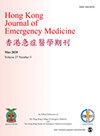Practical tips for performing resuscitative endovascular balloon occlusion of the aorta
IF 0.8
4区 医学
Q4 EMERGENCY MEDICINE
引用次数: 2
Abstract
Background: Hemorrhage is the leading cause of death in trauma settings. Non-compressible torso hemorrhage, which is caused by abdominopelvic and thoracic injuries, is an important cause of subsequent organ dysfunction and poor outcomes in multiple trauma patients. The management of hemodynamically unstable patients with non-compressible torso hemorrhage has changed, and the concept of damage control resuscitation has been developed in the last decades. Currently, resuscitative endovascular balloon occlusion of the aorta (REBOA) as a method of temporary stabilization is the modern evolution of bleeding control, and it is in the middle of a paradigm shift as a treatment for non-compressible torso hemorrhage. Despite its effectiveness in patients with hemorrhagic shock, the application of REBOA remains limited because of lack of experience and troubleshooting guidelines. Objectives: The aim of study was to provide useful tips for the implementing a step-by-step procedure for REBOA in various hospital settings and capabilities. Methods: We introduced REBOA procedures using a REBOA-customized 7 Fr balloon catheter through the animation models or radiography from preparation to access, catheter management, and device removal after procedure completed. Results: We have described REBOA procedures as follows: identification of the common femoral artery, arterial access for placement of a guidewire, precautions during a sheath insertion, guidewire and balloon positioning in the aorta, occlusion zones and adjustment of balloon location, REBOA strategy for extending the occlusion time, balloon deflation and removal, sheath removal, and medical records. Conclusion: We believe that the practical tips mentioned in this article will help in performing the REBOA procedure systematically and developing an effective REBOA framework.主动脉腔内球囊闭塞复苏术的实用技巧
背景:出血是创伤环境中死亡的主要原因。由腹骨盆和胸部损伤引起的不可压缩性躯干出血是多发性创伤患者随后器官功能障碍和不良预后的重要原因。在过去的几十年里,血液动力学不稳定的不可压缩性躯干出血患者的管理发生了变化,损伤控制复苏的概念也得到了发展。目前,作为一种暂时稳定的方法,复苏性血管内球囊闭塞主动脉(REBOA)是出血控制的现代发展,它正处于治疗非压迫性躯干出血的范式转变之中。尽管REBOA对失血性休克患者有效,但由于缺乏经验和故障排除指南,其应用仍然有限。目的:本研究旨在为在各种医院环境和能力下实施REBOA的分步程序提供有用的提示。方法:我们通过动画模型或射线照相介绍了使用REBOA定制的7Fr球囊导管的REBOA程序,从准备到进入、导管管理,以及程序完成后的设备移除。结果:我们描述了REBOA程序如下:股总动脉的识别、放置导丝的动脉通路、鞘管插入过程中的注意事项、导丝和球囊在主动脉中的定位、闭塞区和球囊位置的调整、延长闭塞时间的REBOA策略、球囊收缩和移除、鞘管移除,以及医疗记录。结论:我们相信本文中提到的实用技巧将有助于系统地执行REBOA程序并开发有效的REBOA框架。
本文章由计算机程序翻译,如有差异,请以英文原文为准。
求助全文
约1分钟内获得全文
求助全文
来源期刊

Hong Kong Journal of Emergency Medicine
EMERGENCY MEDICINE-
CiteScore
1.50
自引率
16.70%
发文量
26
审稿时长
6-12 weeks
期刊介绍:
The Hong Kong Journal of Emergency Medicine is a peer-reviewed, open access journal which focusses on all aspects of clinical practice and emergency medicine research in the hospital and pre-hospital setting.
 求助内容:
求助内容: 应助结果提醒方式:
应助结果提醒方式:


